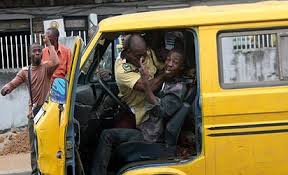
THE announcement that plans are afoot to “remove” the ubiquitous yellow-painted minibuses from Lagos roads hit Lagosians like a bolt. Coming directly from Governor Akinwunmi Ambode, the news compelled attention since the state government, unlike its federal and state peers, has built a reputation for bold action in the last 17 years. The move is long overdue and the government should remain steadfast in its pursuit of the megacity status for Lagos.
Like many observers, we are sceptical of the timeline: ridding Lagos of the menace of the yellow-painted buses may require time. Notice that the phased withdrawal of the Molue, another malevolent denizen of the roads, is not yet complete. But there should be an urgency to evict Danfo from the city, especially from the main highways, and realise a modern inter-modal transport system befitting of Africa’s largest city.
True, the minibuses provide a vital service, moving hundreds of thousands of people and goods daily; but they have become a nightmare, a primary cause of gridlock, accidents and fatalities, according to LASTMA, the state’s traffic agency. They speed excessively, load excess passengers and goods and disobey every rule in the book. Only about 20 per cent of the Danfos carry genuine mandatory documents, estimate traffic officials. Worse, like their newer and equally deadly cousins, the Okadas, they are used extensively to commit crimes – robbery, kidnapping, and electoral violence. The drivers and conductors are often rude, dirty-looking, violent and thuggish.
Ambode was short on details, but he captured the angst of Lagosians in his lamentation over the out-dated transport platforms. “When I …see all the yellow buses, Okadas (commercial motorcycles), and all kinds of tricycles, I feel that the claim that we are a megacity is not true.” Actually, Lagos is a megacity, at least by the United Nations’ designation of metropolitan areas with over 10 million people as such. It ranks 13th with an estimated population of 21 million, after cities like Delhi, Beijing and Sao Paulo. Where it falls short is in the quantum and quality of its infrastructure, especially public transport, which the state has been making brave efforts to reverse since 1999.
It is the Nigerian story of neglect, incompetence and poor leadership writ large that brought Lagos to this sorry pass. Between 1984 and 1999, investment in infrastructure was very little and did not keep pace with the city’s population explosion, which the loss of its status as the country’s political capital in 1991 did not halt. About 25,000 persons move into Lagos daily, according to a study, with about 8,000 staying put for varying periods. Of the 10.6 million vehicles registered in the country as of 2016, says the Federal Road Safety Corps, a quarter are in Lagos, plying its 9,100 federal, state and local roads. The phenomenal increase in human and vehicular traffic is seen in figures showing that there were 20,000 mini buses, 6,000 medium-sized buses and 30,000 taxis in the city in 1985. Estimates put the number of minibuses in Lagos today at over 100,000.
With the collapse of public transport through the bankruptcy of the bus, ferry and road networks, mini buses, motorbikes and the ugly Molue and Okadas came in to fill the void. The famed “go-slow” gave way to gridlock. According to the Lagos Metropolitan Area Transport Authority, the state suffers economic losses of N250 billion annually due to traffic congestion. At major points and routes, the lawlessness of minibus drivers causes traffic snarls and accidents. Despite the massive investment of the state government on roads, bus stops, bridges, pedestrian flyovers, the Bus Rapid Transport System, traffic management and law enforcement, Danfo drivers remain a major hindrance to free-flowing traffic.
The state government should press faster ahead with its Strategic Transport Master Plan being spearheaded by LAMATA, the semi-autonomous agency that enjoys World Bank and state counterpart funding. While road repair interventions are moving steadily, its goals of six metro rail lines, one mono rail, 14 BRT routes, 26 water transport routes and three cable cars are sluggish. The first rail line from Mile 2 to Marina has missed several deadlines just like implementation of the water transport segment.
We recommend immediate eviction of the yellow buses first, from the Central Business Districts, the federal roads in the city precincts and the major highways. Given that many more roads need expansion and more investors lured into the system, Lagosians have to live with the Danfo for some time until the state’s master plan comes into full fruition. In the meantime, enforcement of the Lagos State Traffic Law 2012 should be reinvigorated to knock discipline into all road users and flush Okada from the 475 roads they are forbidden from plying.
Other megacities should serve as models: London (pop. 13.84m) provides efficient public transport through buses, the underground train system, light rail, tram, water ferries and taxis. The underground carried over 3.7 commuters daily in 2013. Tokyo (pop. 38.8m) has the world’s most extensive urban railway network with 158 lines and 4,714 kilometres of track, interconnected with buses, boats and trams. With efficient subway train network, extensive bus routes and taxis, 54.2 per cent of New York’s 23.63 million residents don’t bother owning cars, a departure from the American “car culture” and 41 per cent use the subway, 12 per cent take buses and 10 per cent walk to their offices! Johannesburg (pop. 4.43m) is investing $1.1 billion to modernise its metro rail system in addition to spending on bus routes.
The road map is, therefore, laid bare: the megacity dream should be pursued with vigour and the eyesore of Danfo consigned to the museum.
END

Be the first to comment